My duck pen has been more or less finished and occupied for a while now but I thought (following some encouragement from duckyfromoz
 ) that I'd post a few pictures of the process of building it. I've modified it along the way.
) that I'd post a few pictures of the process of building it. I've modified it along the way.
My aims in building the pen were to produce something very predator-proof and that was big enough to shut my ducks up in while I was at work and also at night. I wanted to give them bathing water in their pen as well. It had to drain well and be easy to clean (well, we all have to aspire to the near-impossible sometimes....). I also wanted the duck house to be a bit sound-proofed, to avoid neighbour problems over quacking but mainly because the pen was to be built outside my bedroom window! So it needed to smell ok too.....
Here is the pen base. It's made of treated pine railway ties sitting on galvanised welded mesh (to stop foxes digging in - feral foxes are our biggest problem here).
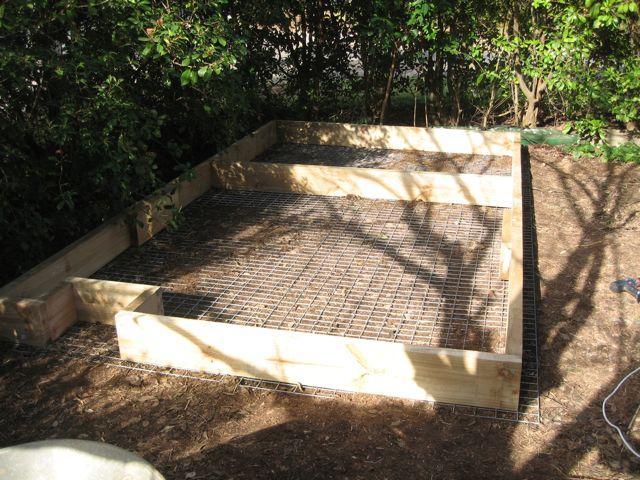
The base was filled with a layer of gravel. My original plan was to cover this with mulch (I use chopped sugar cane leaves). I was assured by those in the know that this'd result in a horrific mess in short order. So I eventually dug out part of the gravel and put in a layer of sand. Now it's about 15cm gravel and 5cm sand. I built the shed up one end.
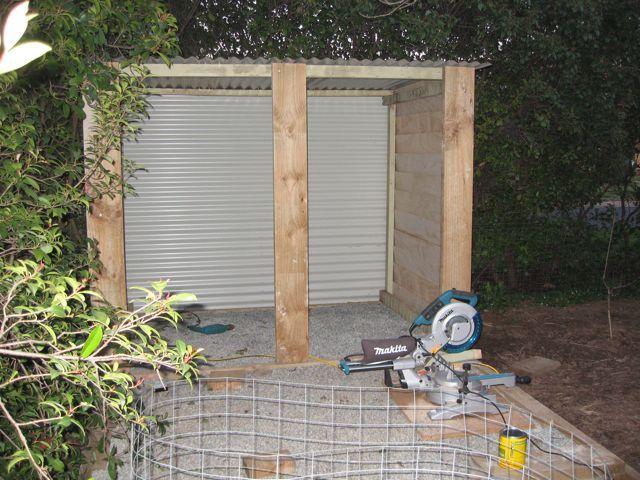
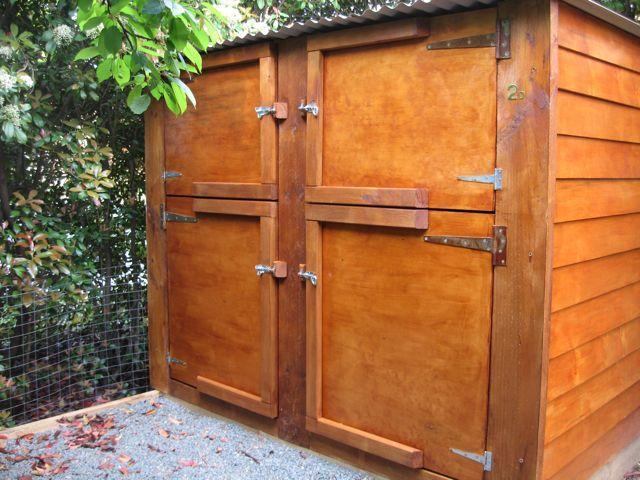
People also assured me that ducks get steamy at night and need good ventilation. I put ventilation 'flaps' in the sides and there is also a large, hinged ventilation flap in the back wall (no picture of this though)
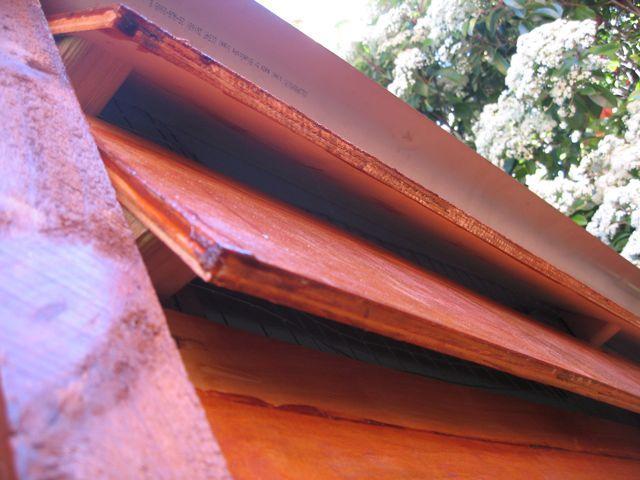
The walls and ceiling have fibreglass sound-proofing insulatation in them:
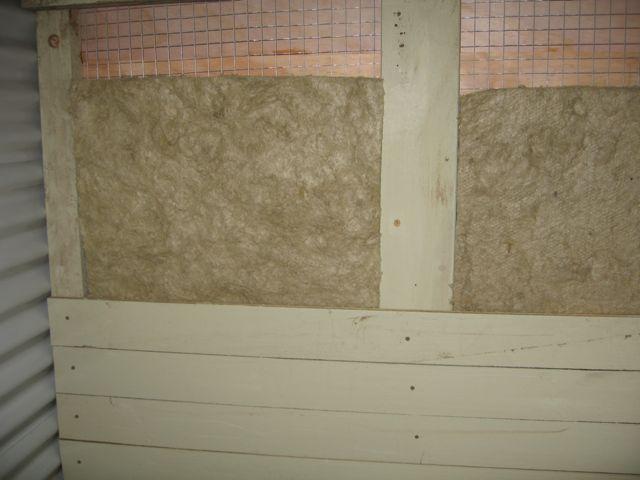
A tip for putting in insulation - make sure you seal up all possible rodent entry points. I have had to take down the ceiling to evict a family of mice who were living very comfortably in the fluffy insulation...

Inside the shed I have a fold-down shelf that I store food and bedding on:
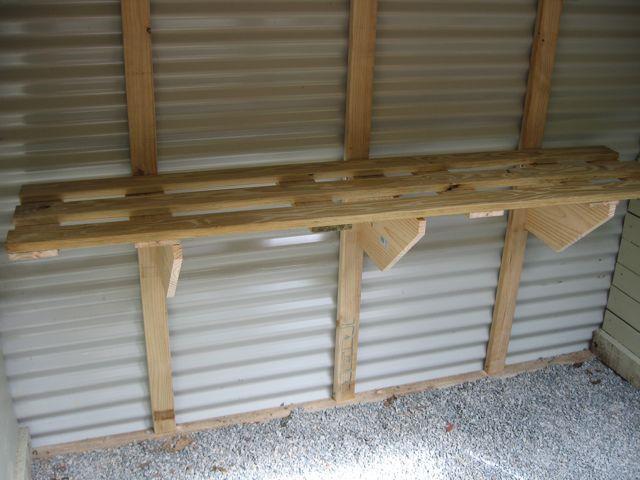
This was the original pond:
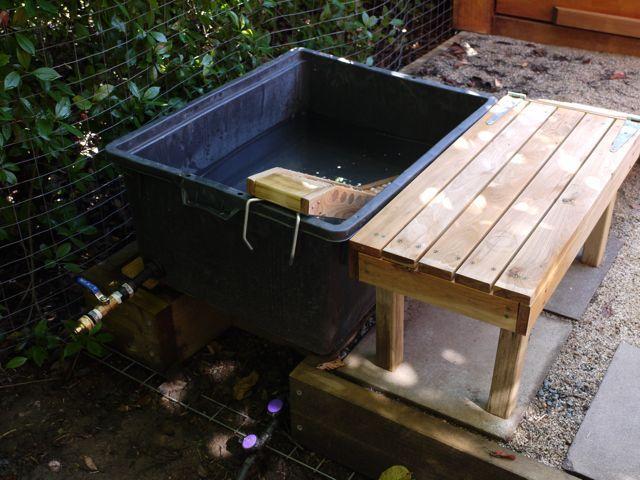
It holds 150 litres (about 40 gallons) and I filled it with water from a rainwater tank. It ended up using way too much rainwater (since I refilled it every day) and taking too long to drain in the winter when everything got frozen.... so I replaced it with a smaller trough a few months later (smaller in volume but not surface area). Pics of that later.
Anyhow, as we all know, ducks love water and almost as much as that they love pooping in water. I didn't want the poopy water to go to waste so the pond(s) drain to a sump:
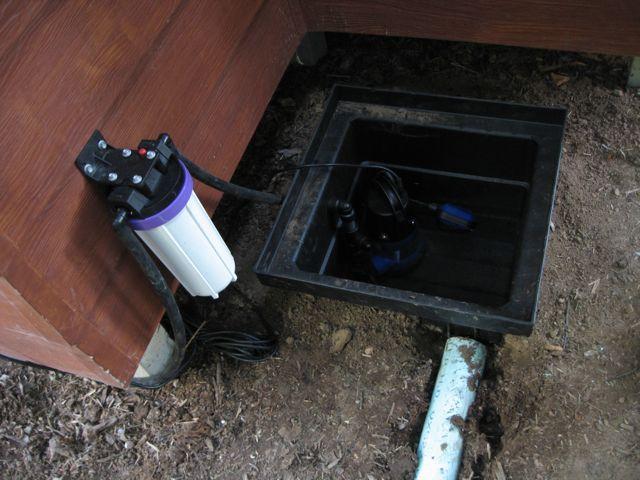
....which pumps water onto the vegetable garden via a drip irrigation system.
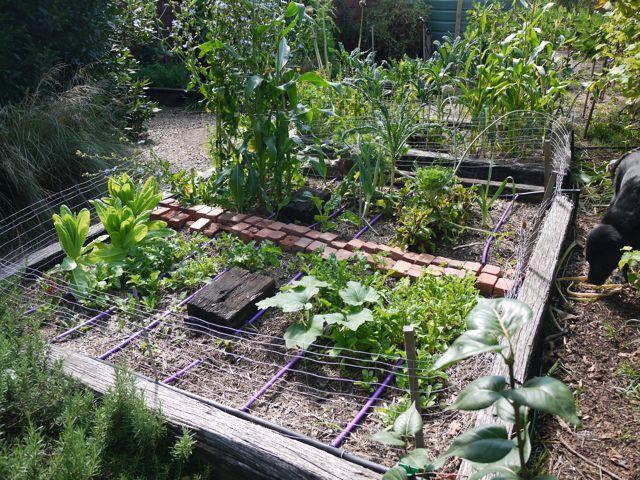
6 months down the track this system is working really well, but, even with a top-quality filter (the white cylinder looking thing on the wall above) I still have to clean the filter daily (I blast it with the hose) and the drip lines need flushing at least every 6 months. But it's not a big deal since I get to use all the nice, pre-fertilised water and I don't have to spend time watering the garden.

Here's the finished pen. It's now got a mesh 'cage' around it and a mesh roof. All set to house ducks!! You can also see the automatic dog waterer I have set up for them (the blue thing).
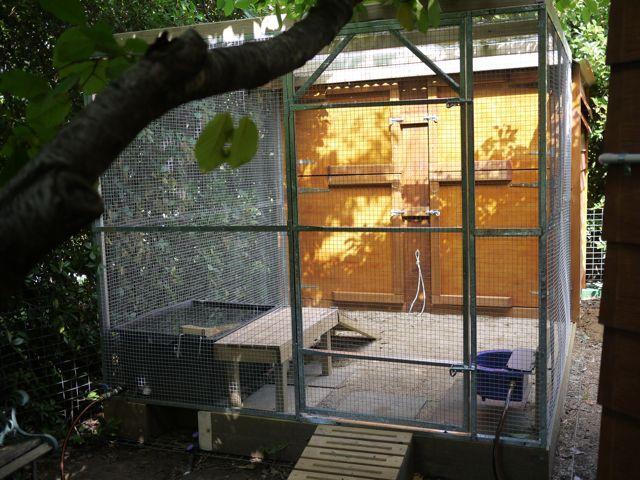
Something was missing though - ducks!!!! Here they are, 2 Swedish drakes, 4 Swedish ducks and 2 cross-bred ducks.

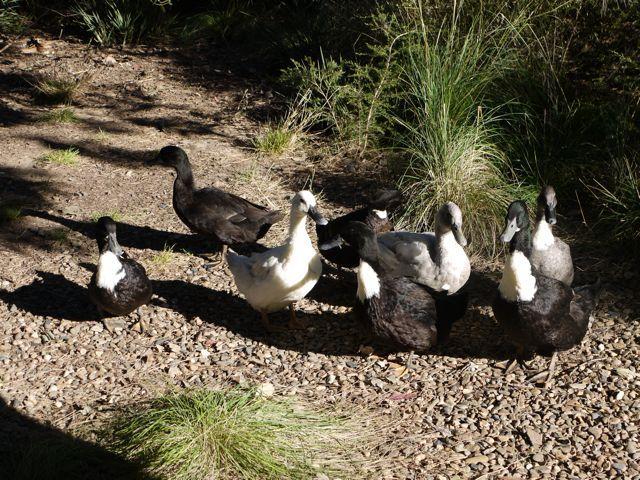
Did I say that the pen was finished? No. It was too small for 8 ducks (which I knew it would be...) so Stage 2 of development swung into action in the form of a duck pen extension:
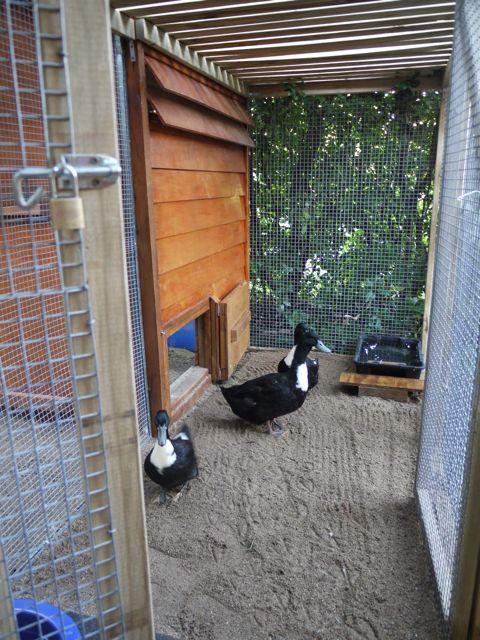
Here is the whole thing....
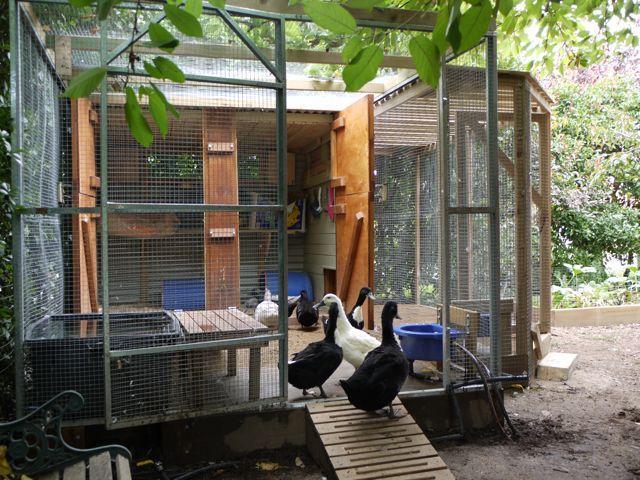
....except then I built a little extension on the extension to house a swimming pool:
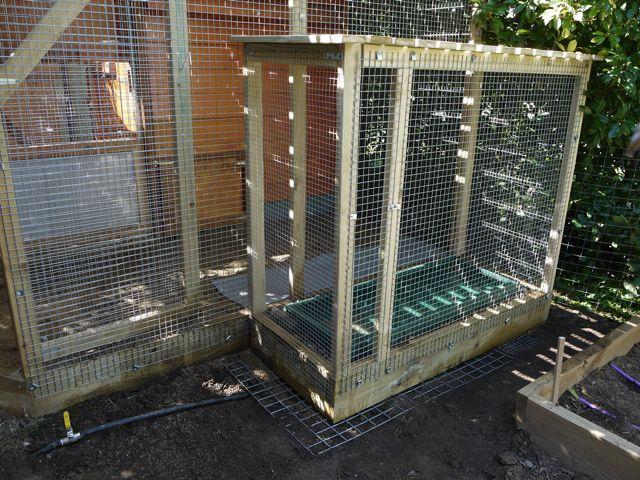
The extension now houses one drake and two ducks and the other 5 are in the original pen. I replaced the tub in the original pen with a green feed trough of the same kind as you see in the pic above. It holds 60 litres (about 15 gallons).
The duck house is divided so they more or less sleep together, separated by a mesh barrier. The blue things in the pic below are nest boxes, made out of a cut-up feed bin.
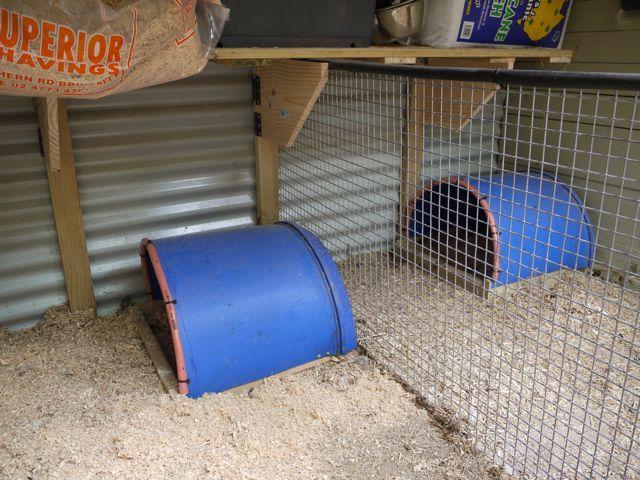
I've made a couple of other changes. The main pen has a paved area around the water sources and this get pooped on to the max. I hose it out, meaning that the area outside the pen was in danger of turning into a poopy morass. I dug drainage trenches and filled them with gravel and put in a bit more paving on the outside:
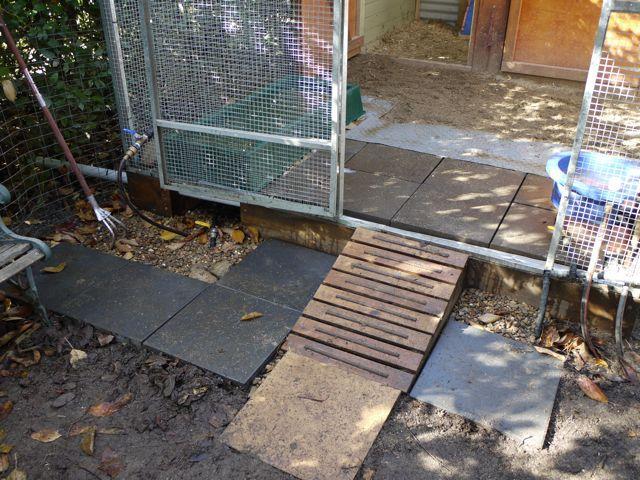
I also got a bit of PVC pip and cut it in half lengthways to make a drain so I could hose the poop into this and then out into the hedge that is beside the duck pen.
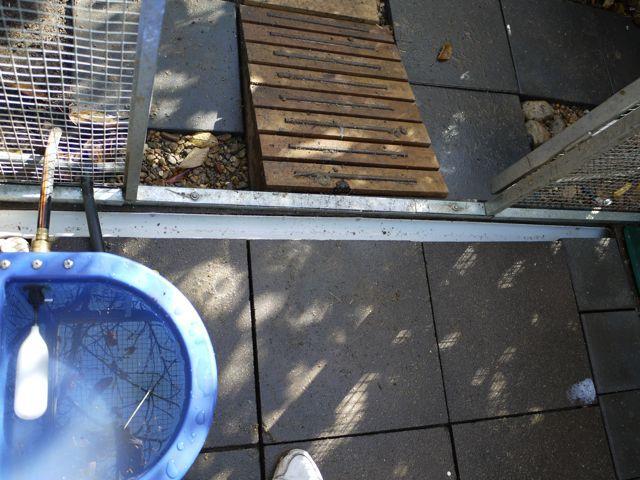
The ducks LOVE puddling in the gross, poopy water that gets hosed out
 Now and then I dig out the area that it drains to and put it all in the worm farm - the worms appreciate it!!
Now and then I dig out the area that it drains to and put it all in the worm farm - the worms appreciate it!!
These pics give an idea of where the pen is relative to the house (the human house). You can see that it's pretty close and also that it has a lot of vegetation around it. The plants/hedge/trees help alot by sucking up splashed out water and poop with their roots and by providing shade.
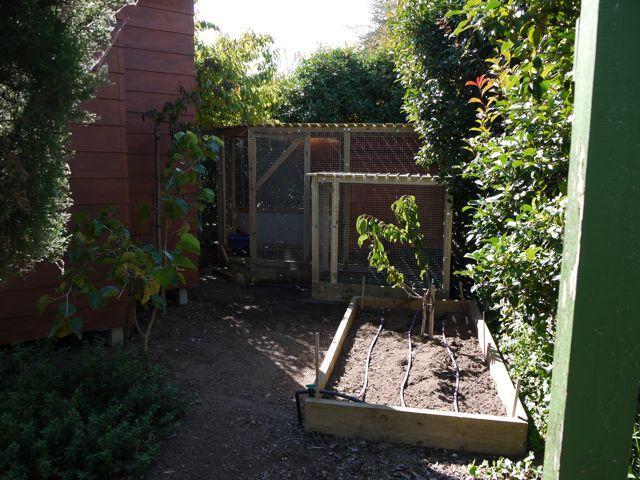
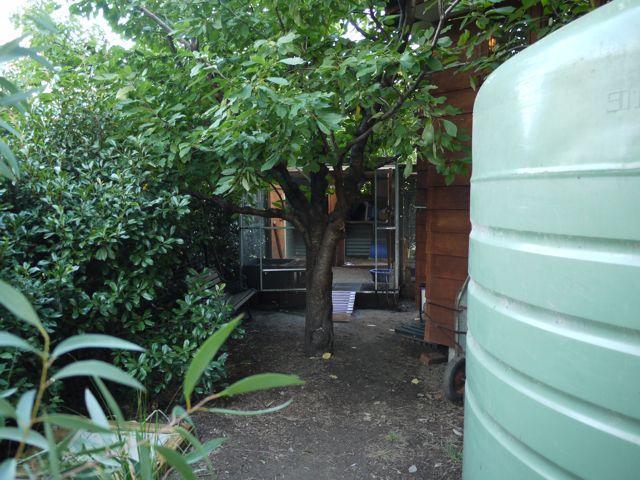
Cleaning the pen is pretty easy, all things considered. It takes me about 20 minutes every day to remove and replace poopy bedding, scoop up poop off the sand, hose the paved areas, and drain and reflll ponds and waterers. I also rake the sand every day, using a garden hoe with three pointy prongs. This is important as it keeps the sand aerated to stop nasty anaerobic bacteria developing. Very important in smell management. Raking also stops the sand getting compacted, which reduces its capacity to drain water away. I am very happy to report that the whole pen smells absolutely fine too. I'd have no problem eating my dinner in there (off a plate of course
 ).
).
Hope you've enjoyed my duck pen journey....at least the journey so far!! Now I just have to build a brooder and a grower pen for the kids!!!


My aims in building the pen were to produce something very predator-proof and that was big enough to shut my ducks up in while I was at work and also at night. I wanted to give them bathing water in their pen as well. It had to drain well and be easy to clean (well, we all have to aspire to the near-impossible sometimes....). I also wanted the duck house to be a bit sound-proofed, to avoid neighbour problems over quacking but mainly because the pen was to be built outside my bedroom window! So it needed to smell ok too.....
Here is the pen base. It's made of treated pine railway ties sitting on galvanised welded mesh (to stop foxes digging in - feral foxes are our biggest problem here).

The base was filled with a layer of gravel. My original plan was to cover this with mulch (I use chopped sugar cane leaves). I was assured by those in the know that this'd result in a horrific mess in short order. So I eventually dug out part of the gravel and put in a layer of sand. Now it's about 15cm gravel and 5cm sand. I built the shed up one end.


People also assured me that ducks get steamy at night and need good ventilation. I put ventilation 'flaps' in the sides and there is also a large, hinged ventilation flap in the back wall (no picture of this though)

The walls and ceiling have fibreglass sound-proofing insulatation in them:

A tip for putting in insulation - make sure you seal up all possible rodent entry points. I have had to take down the ceiling to evict a family of mice who were living very comfortably in the fluffy insulation...

Inside the shed I have a fold-down shelf that I store food and bedding on:

This was the original pond:

It holds 150 litres (about 40 gallons) and I filled it with water from a rainwater tank. It ended up using way too much rainwater (since I refilled it every day) and taking too long to drain in the winter when everything got frozen.... so I replaced it with a smaller trough a few months later (smaller in volume but not surface area). Pics of that later.
Anyhow, as we all know, ducks love water and almost as much as that they love pooping in water. I didn't want the poopy water to go to waste so the pond(s) drain to a sump:

....which pumps water onto the vegetable garden via a drip irrigation system.

6 months down the track this system is working really well, but, even with a top-quality filter (the white cylinder looking thing on the wall above) I still have to clean the filter daily (I blast it with the hose) and the drip lines need flushing at least every 6 months. But it's not a big deal since I get to use all the nice, pre-fertilised water and I don't have to spend time watering the garden.

Here's the finished pen. It's now got a mesh 'cage' around it and a mesh roof. All set to house ducks!! You can also see the automatic dog waterer I have set up for them (the blue thing).

Something was missing though - ducks!!!! Here they are, 2 Swedish drakes, 4 Swedish ducks and 2 cross-bred ducks.


Did I say that the pen was finished? No. It was too small for 8 ducks (which I knew it would be...) so Stage 2 of development swung into action in the form of a duck pen extension:

Here is the whole thing....

....except then I built a little extension on the extension to house a swimming pool:

The extension now houses one drake and two ducks and the other 5 are in the original pen. I replaced the tub in the original pen with a green feed trough of the same kind as you see in the pic above. It holds 60 litres (about 15 gallons).
The duck house is divided so they more or less sleep together, separated by a mesh barrier. The blue things in the pic below are nest boxes, made out of a cut-up feed bin.

I've made a couple of other changes. The main pen has a paved area around the water sources and this get pooped on to the max. I hose it out, meaning that the area outside the pen was in danger of turning into a poopy morass. I dug drainage trenches and filled them with gravel and put in a bit more paving on the outside:

I also got a bit of PVC pip and cut it in half lengthways to make a drain so I could hose the poop into this and then out into the hedge that is beside the duck pen.

The ducks LOVE puddling in the gross, poopy water that gets hosed out

These pics give an idea of where the pen is relative to the house (the human house). You can see that it's pretty close and also that it has a lot of vegetation around it. The plants/hedge/trees help alot by sucking up splashed out water and poop with their roots and by providing shade.


Cleaning the pen is pretty easy, all things considered. It takes me about 20 minutes every day to remove and replace poopy bedding, scoop up poop off the sand, hose the paved areas, and drain and reflll ponds and waterers. I also rake the sand every day, using a garden hoe with three pointy prongs. This is important as it keeps the sand aerated to stop nasty anaerobic bacteria developing. Very important in smell management. Raking also stops the sand getting compacted, which reduces its capacity to drain water away. I am very happy to report that the whole pen smells absolutely fine too. I'd have no problem eating my dinner in there (off a plate of course

Hope you've enjoyed my duck pen journey....at least the journey so far!! Now I just have to build a brooder and a grower pen for the kids!!!

Last edited:





